练习 - 提升到过渡
发布管道现在有三个阶段:“生成”、“开发”和“测试”。 你和 Tailspin 团队还要实现一个阶段:“过渡”。
在本部分中,你将:
- 在 Azure Pipelines 中创建“过渡”环境,并将自己分配为审批者。
- 定义“过渡”阶段,此阶段仅在审批者验证“测试”阶段的结果后才运行。
创建过渡环境
在这里,你将在 Azure Pipelines 中创建用于“过渡”的环境。 为便于学习,你将自己分配为审批者。 在实践中,你将分配用户,在将更改移动到下一个阶段之前,他们需要批准这些更改。 对于 Tailspin 团队,Amita 批准更改,这样它们就可以从“测试”提升到“过渡”。
在本模块前面的部分中,你为“开发”和“测试”阶段指定了 environment 设置。 下面是“开发”阶段的示例。
- stage: 'Deploy'
displayName: 'Deploy the web application'
dependsOn: Build
jobs:
- deployment: Deploy
pool:
vmImage: 'ubuntu-20.04'
environment: dev
variables:
- group: Release
可以通过 Azure Pipelines 定义一个环境,其中包含发布的特定条件。 此条件可以包括授权部署到环境中的管道。 你还可以指定将发布从一个阶段提升到下一个阶段所需的人工审批。 在此处指定这些审批。
创建“过渡”环境:
在 Azure Pipelines 中,选择“Environments”。
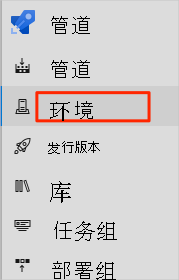
选择“新建环境”。
在“名称”下输入“过渡”。
让其余字段保留其默认值。
选择“创建”。
在“过渡”环境页面上,打开下拉列表,然后选择“审批和检查”。
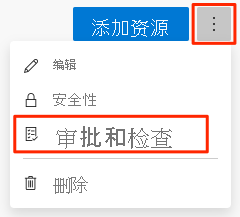
选择“审批”。
在“审批者”下,选择“添加用户和组”,然后选择你的帐户。
在“审批者说明”下,输入“在准备好进行过渡时批准此更改”。
选择“创建”。
将更改提升到过渡
在这里,你将修改管道配置,以将生成部署到“过渡”阶段。
在 Visual Studio Code 中,按如下所示修改 azure-pipelines.yml:
trigger: - '*' variables: buildConfiguration: 'Release' releaseBranchName: 'release' schedules: - cron: '0 3 * * *' displayName: 'Deploy every day at 3 A.M.' branches: include: - release always: false stages: - stage: 'Build' displayName: 'Build the web application' jobs: - job: 'Build' displayName: 'Build job' pool: vmImage: 'ubuntu-20.04' demands: - npm variables: wwwrootDir: 'Tailspin.SpaceGame.Web/wwwroot' dotnetSdkVersion: '6.x' steps: - task: UseDotNet@2 displayName: 'Use .NET SDK $(dotnetSdkVersion)' inputs: version: '$(dotnetSdkVersion)' - task: Npm@1 displayName: 'Run npm install' inputs: verbose: false - script: './node_modules/.bin/node-sass $(wwwrootDir) --output $(wwwrootDir)' displayName: 'Compile Sass assets' - task: gulp@1 displayName: 'Run gulp tasks' - script: 'echo "$(Build.DefinitionName), $(Build.BuildId), $(Build.BuildNumber)" > buildinfo.txt' displayName: 'Write build info' workingDirectory: $(wwwrootDir) - task: DotNetCoreCLI@2 displayName: 'Restore project dependencies' inputs: command: 'restore' projects: '**/*.csproj' - task: DotNetCoreCLI@2 displayName: 'Build the project - $(buildConfiguration)' inputs: command: 'build' arguments: '--no-restore --configuration $(buildConfiguration)' projects: '**/*.csproj' - task: DotNetCoreCLI@2 displayName: 'Publish the project - $(buildConfiguration)' inputs: command: 'publish' projects: '**/*.csproj' publishWebProjects: false arguments: '--no-build --configuration $(buildConfiguration) --output $(Build.ArtifactStagingDirectory)/$(buildConfiguration)' zipAfterPublish: true - publish: '$(Build.ArtifactStagingDirectory)' artifact: drop - stage: 'Dev' displayName: 'Deploy to the dev environment' dependsOn: Build condition: | and ( succeeded(), eq(variables['Build.SourceBranchName'], variables['releaseBranchName']) ) jobs: - deployment: Deploy pool: vmImage: 'ubuntu-20.04' environment: dev variables: - group: Release strategy: runOnce: deploy: steps: - download: current artifact: drop - task: AzureWebApp@1 displayName: 'Azure App Service Deploy: website' inputs: azureSubscription: 'Resource Manager - Tailspin - Space Game' appName: '$(WebAppNameDev)' package: '$(Pipeline.Workspace)/drop/$(buildConfiguration)/*.zip' - stage: 'Test' displayName: 'Deploy to the test environment' dependsOn: Dev #condition: eq(variables['Build.Reason'], 'Schedule') jobs: - deployment: Deploy pool: vmImage: 'ubuntu-20.04' environment: test variables: - group: 'Release' strategy: runOnce: deploy: steps: - download: current artifact: drop - task: AzureWebApp@1 displayName: 'Azure App Service Deploy: website' inputs: azureSubscription: 'Resource Manager - Tailspin - Space Game' appName: '$(WebAppNameTest)' package: '$(Pipeline.Workspace)/drop/$(buildConfiguration)/*.zip' - stage: 'Staging' displayName: 'Deploy to the staging environment' dependsOn: Test jobs: - deployment: Deploy pool: vmImage: 'ubuntu-20.04' environment: staging variables: - group: 'Release' strategy: runOnce: deploy: steps: - download: current artifact: drop - task: AzureWebApp@1 displayName: 'Azure App Service Deploy: website' inputs: azureSubscription: 'Resource Manager - Tailspin - Space Game' appName: '$(WebAppNameStaging)' package: '$(Pipeline.Workspace)/drop/$(buildConfiguration)/*.zip'此代码添加“过渡”阶段。 该阶段部署到“过渡”环境,其中包括发布审批。
提示
你可能已注意到,所有三个部署阶段都遵循类似的步骤。 你可以使用模板一次性定义公共生成任务并多次重复使用它们。 你已在使用 Azure Pipelines 创建生成管道模块中使用了此方法。 为便于学习,我们在每个阶段中重复执行这些步骤。
在集成终端中,将 azure-pipelines.yml 添加到索引中。 接下来,提交更改,并将其推送到 GitHub。
提示
在运行这些 Git 命令之前,请保存 azure-pipelines.yml。
git add azure-pipelines.yml git commit -m "Deploy to Staging" git push origin release在 Azure Pipelines 中,转到生成。 在生成运行时对其进行跟踪。
当生成到达“过渡”时,会看到管道等待所有检查通过。 在本例中,只有一个检查,即手动发布审批。
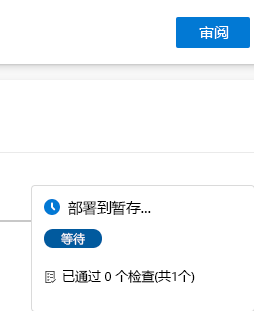
你可以将 Azure DevOps 配置为在生成需要审批时向你发送电子邮件通知。 下面是一个示例:
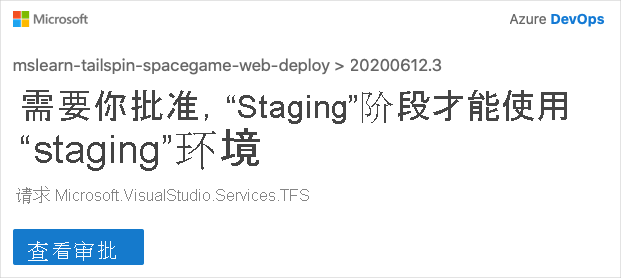
选择“审阅”>“批准”。
实际上,若要验证它们是否满足你的要求,需要检查更改。
生成完成后,打开 Web 浏览器。 转到与过渡环境的应用服务实例关联的 URL。
如果浏览器选项卡仍处于打开状态,请刷新页面。 如果你忘记了 URL,可在 Azure 门户中的应用“服务详细信息”页上找到它。
你会看到 Space Game 网站部署到应用服务,并且正在运行。
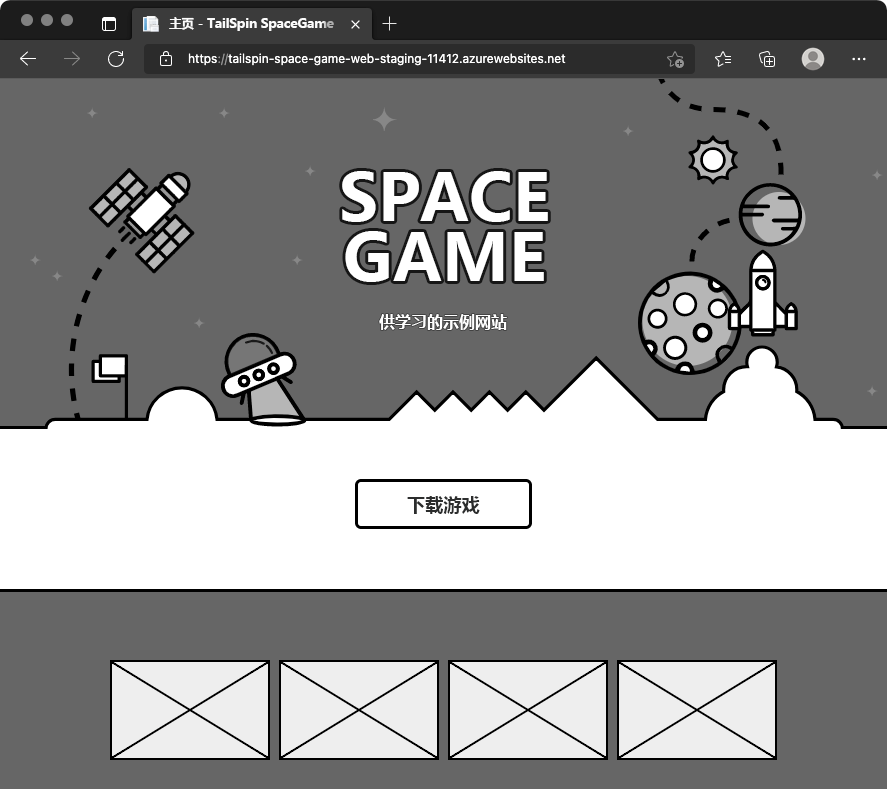
(可选)在 Azure Pipelines 中选择“环境”。 接下来,选择“过渡”环境。
Azure Pipelines 记录部署历史记录,这使你可以将环境中的更改追溯到代码提交和工作项。

Tailspin 团队聚集在一起讨论他们的进展。 Amita 批准“测试”阶段中的更改,而其他人则进行监视。
Tim:说实话,起初我对自动发布管道有些不安。 但我现在真的很喜欢它,因为我看到它起作用了。 每个阶段都可以有自己的环境、关联的测试和审批者。 管道将许多我们必须手动执行的操作自动化。 但是我们仍然可以在需要的地方进行控制。
Amita:我可以想象我们执行类似的操作,将更改从“过渡”提升到“生产”。 说到这个...我们何时添加生产环境?
Andy:很快了。 我认为在添加生产环境之前,我们仍然需要先在此处填写几项信息。